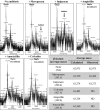Exploration of the role of the penicillin binding protein 2c (Pbp2c) in inducible β-lactam resistance in Corynebacteriaceae
- PMID: 38784795
- PMCID: PMC11111852
- DOI: 10.3389/fmicb.2024.1327723
Exploration of the role of the penicillin binding protein 2c (Pbp2c) in inducible β-lactam resistance in Corynebacteriaceae
Abstract
Six genes encoding putative high molecular weight penicillin-binding proteins (Pbp) are present in the genome of the β-lactam-resistant strain Corynebacterium jeikeium K411. In this study, we show that pbp2c, one of these six genes, is present in resistant strains of Corynebacteriaceae but absent from sensitive strains. The molecular study of the pbp2c locus from C. jeikeium and its heterologous expression in Corynebacterium glutamicum allowed us to show that Pbp2c confers high levels of β-lactam resistance to the host and is under the control of a β-lactam-induced regulatory system encoded by two adjacent genes, jk0410 and jk0411. The detection of this inducible resistance may require up to 48 h of incubation, particularly in Corynebacterium amycolatum. Finally, the Pbp2c-expressing strains studied were resistant to all the β-lactam antibiotics tested, including carbapenems, ceftaroline, and ceftobiprole.
Keywords: Corynebacteria; Corynebacteriaceae; Corynebacterium jeikeium; Pbp; Pbp2c; β-lactam.
Copyright © 2024 Lavollay, Buon, Le Moigne, Compain, Guyonvarch and Fonvielle.
Conflict of interest statement
The authors declare that the research was conducted in the absence of any commercial or financial relationships that could be construed as a potential conflict of interest.
Figures








Similar articles
-
Genetic basis of β-lactam resistance in Corynebacterium auriscanis and association with otitis externa in dogs and cats.Vet Microbiol. 2025 Jun;305:110526. doi: 10.1016/j.vetmic.2025.110526. Epub 2025 Apr 24. Vet Microbiol. 2025. PMID: 40319560
-
The beta-lactam-sensitive D,D-carboxypeptidase activity of Pbp4 controls the L,D and D,D transpeptidation pathways in Corynebacterium jeikeium.Mol Microbiol. 2009 Nov;74(3):650-61. doi: 10.1111/j.1365-2958.2009.06887.x. Epub 2009 Oct 6. Mol Microbiol. 2009. PMID: 19807868
-
Fatal Respiratory Diphtheria Caused by ß-Lactam-Resistant Corynebacterium diphtheriae.Clin Infect Dis. 2021 Dec 6;73(11):e4531-e4538. doi: 10.1093/cid/ciaa1147. Clin Infect Dis. 2021. PMID: 32772111
-
Complete genome sequence and analysis of the multiresistant nosocomial pathogen Corynebacterium jeikeium K411, a lipid-requiring bacterium of the human skin flora.J Bacteriol. 2005 Jul;187(13):4671-82. doi: 10.1128/JB.187.13.4671-4682.2005. J Bacteriol. 2005. PMID: 15968079 Free PMC article.
-
beta-lactam resistance in Streptococcus pneumoniae: penicillin-binding proteins and non-penicillin-binding proteins.Mol Microbiol. 1999 Aug;33(4):673-8. doi: 10.1046/j.1365-2958.1999.01521.x. Mol Microbiol. 1999. PMID: 10447877 Review.
References
-
- Barzantny H., Guttmann S., Lässig C., Brune I., Tauch A. (2013). Transcriptional control of lipid metabolism by the MarR -like regulator FamR and the global regulator GlxR in the lipophilic axilla isolate Corynebacterium jeikeium K 411. Microbial Biotechnol. 6, 118–130. doi: 10.1111/1751-7915.12004, PMID: - DOI - PMC - PubMed
LinkOut - more resources
Full Text Sources
Molecular Biology Databases
Research Materials
Miscellaneous

